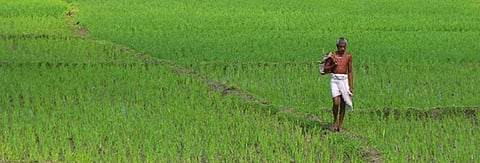

Basudev Mandal, a marginal farmer in Bihar’s Purnea district, was pleased with his bumper crop of maize till early April. But an unexpected spell of heavy rains dashed all his hopes of having a healthy yield.
It’s almost May but an unusual phenomenon is unfolding in Bihar: Heavy rains, strong winds and average temperature less than 30 degrees Celsius.
The erratic weather has destroyed farmers’ wheat and maize. Litchi and mango growers have also been adversely affected. This has left farmers, scientists and government officials of the state agriculture department heavily under-prepared for the consequences.
The local meteorological department has predicted no change in weather patterns till May 30, 2020.
“Continuous rain spells have pushed us into trouble. Besides maize and wheat, banana and summer fruits like litchi and mango are also hit,” said Mandal.
Abdus Sattar, agro-meteorologist at the Rajendra Prasad Central Agricultural University in state’s Samastipur district, told Down To Earth that continuous wet spell for a period of 10-15 days was unprecedented for April.
“Total rainfall recorded April was 110 millimetre against the normal of 15-25 mm. Rains lashed uniformly across the state,” he said.
Bihar is experiencing the highest April rainfall since 1995, Sattar claimed. It recorded 63 mm rainfall in 2017; 67.3 mm in 2003; 60 mm in 2004; and 58.2 mm in 1998.
He added in the last 25 years, the state recorded 0 mm rainfall six times; three times below 10 mm; six times between 10 and 30 mm.
“If one analyses the available data of 10 years or more, rainfall was less than 15 mm from late March to April,” said Ujjawal Kumar, head of the division of socio-economics and extension at Indian Council of Agricultural Research, Patna.
Kumar said that average temperature, too, was below normal for this time.
“The rains damaged mango and banana crops in Seemanchal (northeast) and Koshi region. Agriculture and horticulture are two main sources of livelihood there,” Mandal said.
Maize, too, will suffer a blow this time, Mandal added. The crop is grown in about 140,000 hectares Seemanchal region, comprising Araria, Kishanganj, Purnea and Katihar. In the neighboring districts of Madhepura, Saharsa and Supaul that form the Koshi region, maize is grown in about 60,000 hectares.
Bihar, the third largest producer of maize, has a high maize productivity of 3,904 kilogram / hectare, which is more than the national average of 2,889 kg/ha, according to government’s agriculture department officials.
The state produced 1.36 million tonnes of the crops in 2005-06. This increased to 3.85 million tonnes in 2016-17, as the high-yielding maize of Rabi season replaced winter wheat and paddy in the state.
Purnea’s agriculture officer Sanjay Kumar said: “We have assessed the damage and sent the report to the agriculture department in Patna.”
Farmers in Muzaffarpur district, too, faced heavy losses.
Bihar witnessed more than 10 thunderstorms and hail storms with rains in different districts in April, a senior official of joint secretary level in the agriculture department said. At least seven districts, including Purnea, received more than 100 mm rain in the last two weeks; only three districts recorded less than 50 mm rain.
Taking note of the damage, Bihar agriculture minister Prem Kumar said: “The government will compensate farmers who suffered losses due to untimely rains. It would be done on the basis of damage assessment report.”
He added that rains with thunderstorms between April 15 and 19 widely damaged rabi crops. As heavy rains continued between April 26 and 28, farmers’ worries only escalated.
Kumar said the government received compensation claims of 13.23 lakh farmers in the last week of February, 2020 and first week of March. Claims of 3.35 lakh farmers are being processed.
Similarly, the government received compensation claims of 13.13 lakh farmers for rains in the third week of March and officials are verifying it.